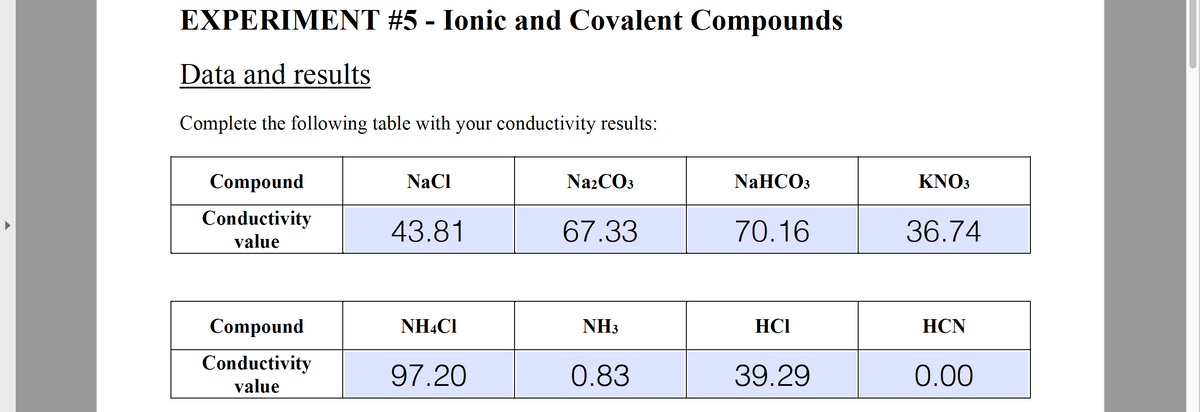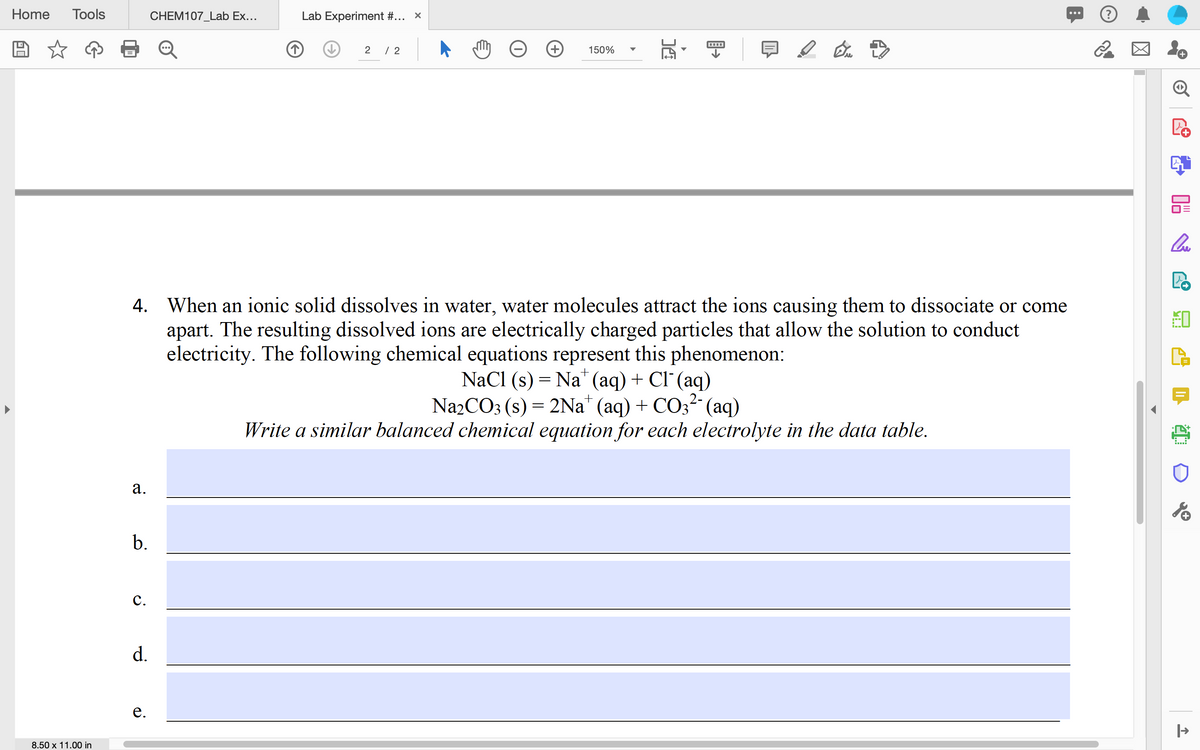When an ionic solid dissolves in water, water molecules attract the ions causing them to dissociate or come apart. The resulting dissolved ions are electrically charged particles that allow the solution to conduct electricity. The following chemical equations represent this phenomenon: NaCl (s) = Na* (aq) + Cl´(aq) Na2CO3 (s) = 2Na* (aq) + CO3? (aq) Write a similar balanced chemical equation for each electrolyte in the data table.
When an ionic solid dissolves in water, water molecules attract the ions causing them to dissociate or come apart. The resulting dissolved ions are electrically charged particles that allow the solution to conduct electricity. The following chemical equations represent this phenomenon: NaCl (s) = Na* (aq) + Cl´(aq) Na2CO3 (s) = 2Na* (aq) + CO3? (aq) Write a similar balanced chemical equation for each electrolyte in the data table.
Principles of Modern Chemistry
8th Edition
ISBN:9781305079113
Author:David W. Oxtoby, H. Pat Gillis, Laurie J. Butler
Publisher:David W. Oxtoby, H. Pat Gillis, Laurie J. Butler
Chapter11: Solutions
Section: Chapter Questions
Problem 60P
Related questions
Question

Transcribed Image Text:EXPERIMENT #5 - Ionic and Covalent Compounds
Data and results
Complete the following table with your conductivity results:
Compound
NaCl
NazCO3
NaHCO3
ΚNO3
Conductivity
43.81
67.33
70.16
36.74
value
Compound
NHẠCI
NH3
HCI
HCN
Conductivity
97.20
0.83
39.29
0.00
value

Transcribed Image Text:Home
Tools
CHEM107_Lab Ex...
Lab Experiment #... x
...
/ 2
150%
4. When an ionic solid dissolves in water, water molecules attract the ions causing them to dissociate or come
apart. The resulting dissolved ions are electrically charged particles that allow the solution to conduct
electricity. The following chemical equations represent this phenomenon:
NaCl (s) = Na" (aq) + Cl¯ (aq)
Na2CO3 (s) = 2Na" (aq) + CO3 (aq)
Write a similar balanced chemical equation for each electrolyte in the data table.
2-
....
а.
b.
c.
d.
е.
8.50 x 11.00 in
Expert Solution
This question has been solved!
Explore an expertly crafted, step-by-step solution for a thorough understanding of key concepts.
This is a popular solution!
Trending now
This is a popular solution!
Step by step
Solved in 2 steps

Knowledge Booster
Learn more about
Need a deep-dive on the concept behind this application? Look no further. Learn more about this topic, chemistry and related others by exploring similar questions and additional content below.Recommended textbooks for you

Principles of Modern Chemistry
Chemistry
ISBN:
9781305079113
Author:
David W. Oxtoby, H. Pat Gillis, Laurie J. Butler
Publisher:
Cengage Learning


Chemistry
Chemistry
ISBN:
9781305957404
Author:
Steven S. Zumdahl, Susan A. Zumdahl, Donald J. DeCoste
Publisher:
Cengage Learning

Principles of Modern Chemistry
Chemistry
ISBN:
9781305079113
Author:
David W. Oxtoby, H. Pat Gillis, Laurie J. Butler
Publisher:
Cengage Learning


Chemistry
Chemistry
ISBN:
9781305957404
Author:
Steven S. Zumdahl, Susan A. Zumdahl, Donald J. DeCoste
Publisher:
Cengage Learning


Chemistry: An Atoms First Approach
Chemistry
ISBN:
9781305079243
Author:
Steven S. Zumdahl, Susan A. Zumdahl
Publisher:
Cengage Learning